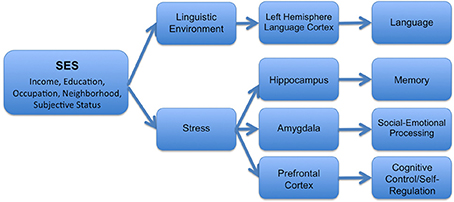frontiersin | Recent advances in neuroimaging methods
have made accessible new ways of disentangling the complex interplay
between genetic and environmental factors that influence structural
brain development. In recent years, research investigating associations
between socioeconomic status (SES) and brain development have found
significant links between SES and changes in brain structure, especially
in areas related to memory, executive control, and emotion. This review
focuses on studies examining links between structural brain development
and SES disparities of the magnitude typically found in developing
countries. We highlight how highly correlated measures of SES are
differentially related to structural changes within the brain.
Introduction
Human development does not occur within a vacuum. The
environmental contexts and social connections a person experiences
throughout his or her lifetime significantly impact the development of
both cognitive and social skills. The incorporation of neuroscience into
topics more commonly associated with the social sciences, such as
culture or socioeconomic status (SES),
has led to an increased understanding of the mechanisms that underlie
development across the lifespan. However, more research is necessary to
disentangle the complexities surrounding early environmental variation
and neural development. This review highlights studies examining links
between structural brain development and SES disparities of the
magnitude typically found in developing countries. We do not include
studies examining children who have experienced extreme forms of early
adversity, such as institutionalization or severe abuse. We also limit
this review to findings concerning socioeconomic disparities in brain
structure, as opposed to brain function.



0 comments:
Post a Comment